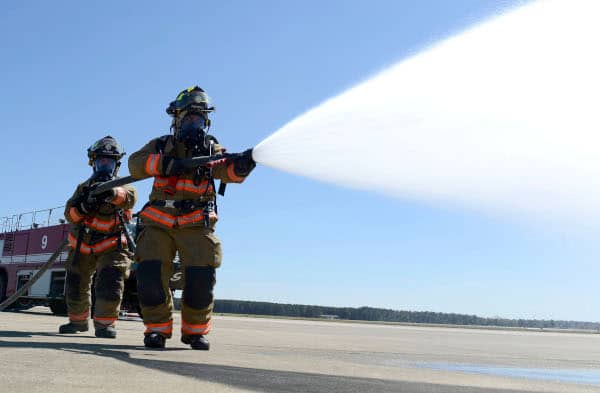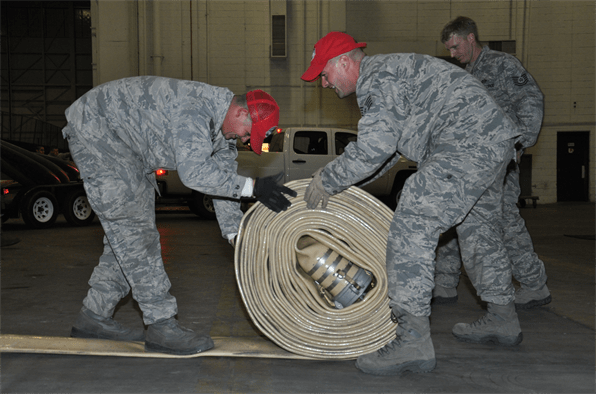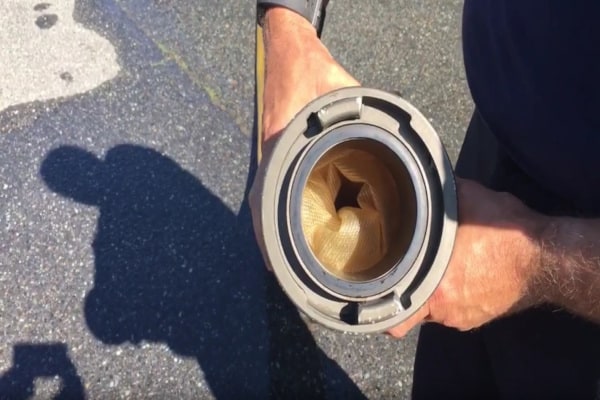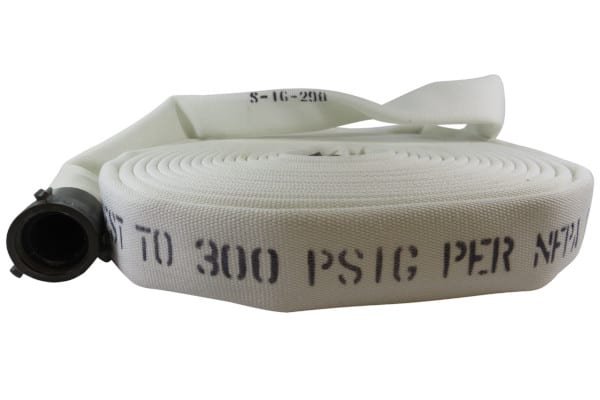Learn the difference between attack and supply fire hose, and the NFPA standards that govern their use
The best fire hoses efficiently move water—and lots of it. But no two kinds of hose are exactly alike. Each is constructed with a specific purpose in mind, whether that’s moving water from a hydrant to a pump or enabling crews in a building to extinguish an active blaze. The features that make some hoses powerful and easy to handle are dead-wrong for other uses.
For fire departments purchasing new hose on a limited budget, these differences are critical. But they can even impact less safety-driven uses of fire hose such as filling a pool, washing a parking lot, irrigating, or simply moving large volumes of water.
In this article, we’ll cover basic types and features of fire hose, the materials that separate the best hose from the worst, and what you need to do to keep the hose you’ve got fully functional.
If you already know what you’re looking for, skip straight to a look at our selection of fire hose.
Most fire hoses are categorized as either attack hose or supply hose
Attack hose is designed to be used by trained firefighters to take down fires too dangerous or too large to be extinguished without professional help. In short, attack hose extinguishes fires. These hoses are built to withstand high water pressure and abrasion, giving firefighters the power and range of movement needed to fight a fire.

Supply hose, on the other hand, moves large quantities of water from hydrants and other pressurized sources to the fire pumps that keep attack hose charged. In general, supply hoses are larger and can move larger volumes of water, but may not be built to withstand quite as much water pressure or bend as often as attack hose.
Guidelines from the National Fire Protection Association govern hose characteristics
Many local governments throughout the United States have embraced fire hose standards set by the National Fire Protection Association (NFPA) as the law of the land. NFPA 1961: Standard on Fire Hose informs firefighters and manufacturers how a fire hose’s design should match its intended use.
Under NFPA 1961, fire hoses must meet a wide range of standards pertaining to their durability, including:
- Resistance to kinking
- Ability to withstand high pressures
- Resistance to heat, abrasion, and moisture degradation
- Strength and reinforcement of hose liners
- Bonding between hose liners and hose jackets
For a fire department on a tight budget, your next purchase of hose may be on fixed funds provided through an equipment or fire service grant. These factors can determine whether your new hose lasts for years to come or fails far sooner. For those using fire hose in industrial or commercial applications, many of these same characteristics will decide whether your hose can deliver water quickly, safely, and at the pressure needed.
Whether it’s fighting large fires, replacing standpipe hose, or even filling a swimming pool, we recommend asking the following important questions:
- Does my fire hose meet the minimum standards where I live, including those specified in NFPA 1961? Will it connect to the hydrants, standpipes, or other water sources I’ll be using?
- Will this hose move enough water? And will it move quickly enough?
- Is the hose easy to grip and maneuver under pressure?
- Is this hose durable under normal working conditions? Will it be ruined by heat, moisture, ultraviolet rays, or just repeated use?
- Is the hose easy to clean and maintain?
The NFPA’s guidelines provide a good starting point, but you’ll need to understand local standards to make sure that you can—and should—connect to local water sources
While the NFPA’s rules form the backbone of most local jurisdictions’ standards for fire hose, the rules that apply where you live and work are established by the local authority having jurisdiction, or AHJ. If you’re still learning the ropes, we recommend contacting your local fire department to get information about your local codes. This is doubly true for facilities managers or contractors looking to make use of fire hydrants. Many districts provide permits and portable water meters for non-emergency water use.
The three most important NFPA standards pertaining to fire hose are:
- Design and construction: NFPA 1961
- Hose care, use, inspection, and testing: NFPA 1962
- Fire hose connections: NFPA 1963
These rules can be reviewed for free online here.
It is important to note that fire hoses are measured according to their internal diameter—the width of the fire hose’s inner liner at its widest point. But even a hose with the correct diameter may not have the threads or couplings needed to connect to local hydrants, valves, or even other hoses. Most modern hose couplings use National Standard Thread (NST) or National Pipe Straight Hose thread (NPSH), but some jurisdictions may require completely different couplings or adapters.
We’ve explained threading standards in another article—feel free to take a look or contact us with your questions.
Standpipe systems require specific hose sizes and types
As mentioned in our series on standpipes—piping systems used to deliver water throughout buildings—class II and III systems are equipped with hose. NFPA 14: Standard for the Installation of Standpipe and Hose Systems requires that not more than 100 feet of listed, 1 1/2″ lined, collapsible or non-collapsible fire hose be attached and ready for use.
Class II systems provide either 1 1/2″ hose stations or a hose connection for fire departments. A minimum 1″ hose may be used in light-hazard occupancies where approved by the AHJ. Class III systems use 1 1/2″ hose—or hose no smaller than 1″ in light hazard occupancies where investigated and listed and where approved by the AHJ.
If you’re new to standpipes or just need a refresher, how about a look at our overview of standpipe systems?
Large-diameter hoses can move more water quickly, but smaller hoses are often better-suited to applications where pressure matters
Fire hoses with a larger diameter can move more gallons of water per foot of hose. NFPA 1961 mandates that supply hose have a minimum 3 1/2″ internal diameter. No minimum or maximum size is specified for attack hose, but for reasons we’ll discuss soon, these hoses tend to be smaller than supply hoses.
In a recent article, we conducted a size-by-size comparison of double-jacket fire hose. This effort showed that 100 feet of 1 1/2″ Superior Fire Hose can fill a 13,000-gallon swimming pool in just under an hour and a half, while the same length of 2” hose does the same work in only 52 minutes.
However, more volume doesn’t mean more pressure. The water pressure delivered by a hose is measured in PSI, or pounds per square inch. Attack hoses, while smaller and lighter than supply hoses, have a higher minimum design service test pressure of 300 PSI. They’re designed to handle this much pressure regularly, and samples from that hose are tested to three times that pressure. For reference, that’s more than five times the power provided by a garden hose. It’s also roughly ten percent of the PSI delivered by the most powerful pressure washers.
The diameter of some hoses may stretch under pressure. This can make it difficult for fire professionals to precisely measure how much water pressure they’re losing as the water passes through the hose. Where accurate estimates of pressure are required, it’s important to ask the manufacturer or the seller for hose-specific data concerning how the hose’s construction impacts the pressure it delivers during use.

The material used to construct the outside of a hose determines its flexibility, while hose size can have a noticeable impact on weight
The NFPA’s standard on fire hose requires that attack hoses be constructed from materials that, among other things, can withstand repeated bending.
From the 2013 edition of NFPA 1961
5.5.1 The material selected in 5.3.1 and 5.4.2 for the construction of attack hose shall be capable of being manufactured into a hose that has all of the following qualities:
5.5.1.4 Ability to withstand 100,000 cycles of repeated bending [hose size of 3 ½ in. (90mm) or less nominal size]
Because they carry water from a fixed location or large hose to the source of the flames, it needs to be able to bend around corners and move somewhat without breaking.
The weight and pressure of water may make using larger sizes difficult. For applications where the hose needs to be moved during use, larger hoses may be less than ideal. In fact, some favor 1 3/4″ or even 1 1/2″ attack hoses for just these reasons.
This brings us to another topic: fire hose jackets.
A fire hose jacket wraps around the liner of the fire hose and gives the fire hose its strength. The liners themselves can’t withstand much pressure. Instead, it’s a fire hose’s jacket that keeps a hose from bursting. Two types are common: woven jackets and rubber jackets.
Woven jackets are made from synthetic material like nylon or polyester. The way these threads are woven impacts the flexibility and kink-resistance of the hose. Each jacket material may be available in single or double-jacket. Single-jacket hose is lighter and more flexible; double jacket is more durable.
Fire hose jackets must meet standards governing durability
Hoses meeting the standards established in NFPA 1961 are constructed from materials meant to be both flexible and pressure-resistant. Materials used to construct attack hose must be capable of withstanding 2,000 pressure cycles. These tests confirm that the water could be turned on and off thousands of times at the hose’s rated pressure.
While the specifics vary with each manufacturer, jackets made from polyester are generally more resistant to abrasion than their nylon counterparts. Single-jacket hoses, while lighter and more flexible, are more susceptible to abrasion and heat than double-jacket hoses, which have an additional protective layer. The jacket’s weave determines which of the synthetic threads are least vulnerable to abrasion. It also contributes to its strength under pressure.
Hoses can be ruined quickly when not properly cleaned, dried, and stored. Every hose can be maintained, as we’ll discuss below. But rubber hoses and some coated hoses are easier to clean than uncoated synthetic hoses. They’re also more resistant to chemical and abrasive damage, and can be wiped down instead of washed.
Fire hose liners must be durable and form a long-lasting bond with the jacket
Beneath the jacket of each fire hose is the inner lining, where water moves from one end of the hose to the other. These linings fail for a variety of reasons: they melt, crack, or separate from the jacket (also known as delamination). The NFPA specifies that liners should be made from rubber compounds, thermoplastic material, blends of rubber and thermoplastic, or natural rubber-latex-coated fabric.

EPDM—short for ethylene propylene diene monomer—is a widely-used and affordable form of liner. It’s commonly found in cars as a door seal, and it’s favored for use in applications where water resistance is critical.
Thermoplastic liners are similar but are somewhat more susceptible to heat. Unlike EPDM or thermoplastic, extruded liners are applied to the inner jacket of fire hose in a liquid state, forming a seal between liner and jacket. This adhesion should meet or exceeds NFPA standards to keep hose in working order, particularly for EPDM and thermoplastic liners.
Fire hose life can be extended with routine cleaning and proper care
When hoses are exposed to too much heat, the hose may lose flexibility and become fragile. Hoses that have exceeded their service life or are bent in one place too many times may burst. Torn jackets indicate that excessive chafing—across sharp, rough, or angled surfaces—has worn out the hose. And neat breakages in the hose may indicate that the hose was under too much pressure.
Many of these situations can be prevented with proper maintenance and cleaning. NFPA 1962: Standard for the Care, Use, Inspection, Service Testing, and Replacement of Fire Hose, Couplings, Nozzles, and Fire Hose Appliances recommends gently cleaning hose with a dry, soft-to-medium bristled brush. Nitrile or rubber-covered hose can simply be wiped clean.
When hoses need to be washed, they should be unrolled, stretched, and gently cleaned using water and mild soap. Pressure-washing, using solvents, or hard scrubbing damage the hose’s outer lining.
After cleaning, the liner should be inspected for delamination. Couplings should be checked for damaged threads, corrosion, and other problems. They should also be checked that the connections rotate freely, are not missing lugs, that the external collar isn’t loose and that the internal gasket is in good condition, and that no other issues are apparent.
Looking for more detailed guidance on cleaning and inspecting fire hose? See our blog post on proper fire hose cleaning techniques.
Purchase new fire hose that meets or exceeds each of these standards
We’ve covered the basics of choosing a fire hose that’s flexible, durable, usable, and easy to maintain. In our next entry, we’ll look at the fire hose nozzles that transform large volumes into effective fire-fighting streams.
If you’re looking to purchase fire hose, QRFS carries hoses suited to a wide range of uses. We offer hose made by Superior Fire Hose, which comes standard with abrasion and damage-resistant polyester jackets. Superior’s hose prevents delamination with double the required adhesion between the liner and jacket. We carry hose in sizes from 1 ½” to 4″ in lengths from 50 feet to 100 feet—all backed by a 10-year warranty.
Click here to shop our selection of fire hose.
Questions? Need help finding or choosing your hose? Call us at +1 (888) 361-6662 or email support@qrfs.com.
If this article helped you find the hose you needed, check us out at Facebook.com/QuickResponseFireSupply or on Twitter @QuickResponseFS.



Hi I’m wondering where I can buy wide fire hose from? Not actually going to be used for intended purposes, but to make something out of.. I’d required $5-$10 MTRS. Any help would be greatly appreciated.. even used fire hose, if anyone sells that..
Kind regards,
Angela
Angela, I would try Repurposed Materials which sells used fire hose. Hope this helps!
Dear sir/madam,
I am bidding to supply to the Malaysian government Fire and Rescue service 500 units “Fire Fighting Attacking Hose (type 3) 1 3/4 inches.I have got the the specification and other
requirements and i need to send the attachment.Could you let me know the person in charge .
Thank you.
Akbar Ali
Akbar, thanks for reaching out. We will have someone from our QRFS Customer Support Team contact you.